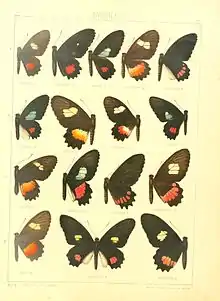Parides iphidamas
Parides iphidamas, the Iphidamas cattleheart or Transandean cattleheart, is a species of Neotropical butterfly in the family Papilionidae.[1][2]
| Iphidamas cattleheart | |
|---|---|
%252C_dorsal.jpg.webp) | |
| Male, dorsal view | |
| Scientific classification | |
| Kingdom: | |
| Phylum: | |
| Class: | |
| Order: | |
| Family: | |
| Tribe: | |
| Genus: | |
| Species: | P. iphidamas |
| Binomial name | |
| Parides iphidamas (Fabricius, 1793) | |
| Synonyms | |
| |
Subspecies
- P. i. iphidamas (Fabricius, 1793) (southern Mexico to Panama)[3]
- P. i. ayabacensis (Joicey & Talbot, 1918) (southern Ecuador to northern Peru)[3]
- P. i. calogyna (Rothchild & Jordan, 1906) (western Ecuador)[3]
- P. i. elatos (Rothchild & Jordan, 1906) (northwestern Colombia)[3]
- P. i. gorgonae Vélez & Salazar, 1991 (Colombia)[3]
- P. i. phalias (Rothchild & Jordan, 1906) (central Colombia)[3]
- P. i. teneates (Rothchild & Jordan, 1906) (northeastern Colombia to northwestern Venezuela)[3]
Description

Parides iphidamas has a wingspan of about 10 centimetres (3.9 in). The dorsal sides of the forewings are black, with a broad green and white spots (completely white in females), while the dorsal sides of the hindwings show a broad red band or spot. Along the edges there are many small yellow spots. The undersides of the wings are black with a white band on the forewings and several pink patches on the hindwings.[4][5] The body of the butterfly is black with red dots. The poisonous caterpillars are chocolate brown, with white or brown protrusions resembling thorns. The host plants are various toxic Aristolochia species (A. cordiflora, A. maxima, A. odoratissma, A. pilosa, A. ringens, and A. tonduzii).[3]
Description from Seitz
P. iphidamas. Male: tibiae and 1.segment of the tarsi thickened and covered with fine hairs. Female :forewing at the margin less deep black than in P. erithalion. Mexico to Ecuador and North Venezuela. A common species, which is not easy to distinguish from P. erithalion and P.lycimenes, and is consequently often mistaken for them. — iphidamas F. (= panares Gray, achelous Hopff., incandescens Btlr.) is the Central American form. Male: forewing distally not transparent; the green area usually reduced, always enclosing one or two white spots; often a white spot in the cell; band of the hindwing gradually widened posteriorly, a narrow spot behind the 2.median. Female: cell-spot on the forewing large, usually some smallspots beyond the cell; the spot before the 2.median smaller than the preceding one, or obliquely cut off towards the base; band of the hindwing almost unicolorous bright red, its inner margin evenly curved.South Mexico to Panama. — phalias R & J. (4b). Male: the green area widest posteriorly, reaching to the hindmargin; hindwing with three red spots separate from the cell. Female: forewing slightly transparent at the apex: cell-spot very large; the spot before the 1.median much larger than the preceding one; band of the hindwing very broad, pale on the inner side. Colombia: Magdalena Valley and Cordillera of Bogota. —elatos R & J. Male : the green area smaller than in the preceding subspecies; hindwing with three small red spots. Cauca Valley. — calogyna R. & J. (4b).Male: forewing exteriorly somewhat more thickly scaled than in phalias and elatos, usually a white spot before the 2.median ; hindwing with 3 small red spots, close together. Female: the spot before the 1.median of the forewing larger than the preceding one; band of the hindwing bright red, its inner margin usually white. West Ecuador and west coast of Colombia. —teneates R.&J. Male : the green area narrow, separated from the cell, usually enclosing one or two white spots.Female not known with certainty. North Venezuela and North Colombia.[6]
 Seitz
Seitz
Description from Rothschild and Jordan(1906)
A full description is provided by Rothschild, W. and Jordan, K. (1906)[7]
Distribution
This species is native to the Central and South America. It occurs from southeastern Mexico to Costa Rica, Panama, and Peru.
Habitat
It is common in various habitats, ranging from open lowlands to wooded areas and tropical forests from sea level to 1,200 meters (3,900 ft).[8] Females mainly occur where the caterpillar host plant are located, in forest clearings and along forest edges.
References
- Warren, A. D.; et al. (2010). "Parides iphidamas". Butterflies of America. Retrieved 22 January 2011.
- Glassberg, Jeffrey (2007). A Swift Guide to the Butterflies of Mexico and Central America. Sunstreak Books Inc. ISBN 978-1-4243-0915-3.
- Savela, Markku. "Parides iphidamas". funet.fi. Retrieved 22 January 2011.
- Lewis, H. L., 1974 Butterflies of the World ISBN 0-245-52097-X Page 26, figure 11 (male) figure 12 (female, underside)
- Brian McAndrew, Butterflies – James Lorimer & Co. Ltd Publishers
- Seitz, A. ed. Band 1: Abt. 1, Die Großschmetterlinge des palaearktischen Faunengebietes, Die palaearktischen Tagfalter, 1909, 379 Seiten, mit 89 kolorierten Tafeln (3470 Figuren)
 This article incorporates text from this source, which is in the public domain.
This article incorporates text from this source, which is in the public domain. - Rothschild, W. and Jordan, K. (1906). A revision of the American Papilios. Novitates Zoologicae 13: 411-752. (Facsimile edition ed. P.H. Arnaud, 1967) and online
- Collins, N. Mark; Morris, Michael G. (1985). "Parides iphidamas (Fabricius, 1793)". Threatened Swallowtail Butterflies of the World: The IUCN Red Data Book. Gland & Cambridge: IUCN. p. 69. ISBN 978-2-88032-603-6 – via Biodiversity Heritage Library.
- Edwin Möhn, 2007 Butterflies of the World, Part 26: Papilionidae XIII. Parides Verlag Goecke & Evers Verlag Goecke & Evers ISBN 9783937783277
Further reading
| Wikispecies has information related to Parides iphidamas. |
- Lamas, Gerardo (2004). Atlas of Neotropical Lepidoptera; Checklist: Part4A Hesperioidea–Papilionoidea. Gainesville, Florida: Scientific Publishers, Inc. p. 93. ISBN 0-945417-28-4.
| Wikimedia Commons has media related to Parides iphidamas. |